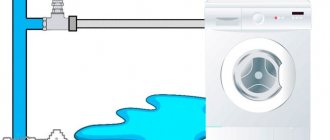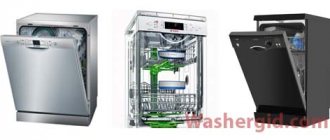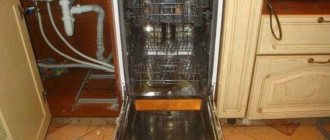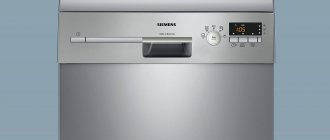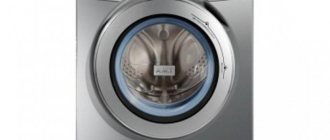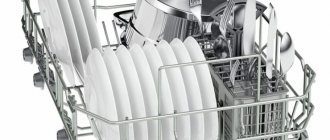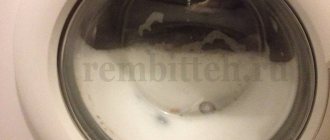A dishwasher has long ceased to be a luxury - it is as necessary and useful a household device as a washing machine or a vacuum cleaner. However, many people are just starting to use dishwashers or have simply never thought about how to do it correctly, even if they have not washed dishes by hand for a long time.
We asked several questions about the operation and selection of dishwashers to Alexander Kryuchenkov, leading product manager at the famous European manufacturer of household appliances Candy .
How a dishwasher works
Copying the washing process, water enters the dishwasher bypassing the inlet valve. Single knot. Water fills the tank, touching the level of the lower waterproofing of the door, sometimes heats up, and is pumped through a pipe into the rocker arms by a recirculation pump. A rain of jets washes the dishes, the individual holes are directed to create a torque on the rocker. Movement is happening.
Water is collected by the lower part of the compartment, passes through a cascade of coarse and fine filters, is collected by a settling tank, and is re-supplied according to the program. Once completed, the sump pump releases the dirty stream into the sewer.
The progress of the cycle is monitored by a pressure switch, the heating element heats the water if necessary, the solenoid valve adds softening salt according to the readings of the sensor set to the regulator. Powder and other products are poured into the door dispenser and thrown into the working chamber as the need arises.
Let us add that the pressure switch pressure is taken in two places:
- On the side tank, water is stored during the filling period (preheating).
- The level in the settling tank is controlled during descent.
It is clear that the central board is free to use the information in various ways.
Dishwasher
Possible malfunctions
If the detergent is not washed out of the compartment, it is possible that its lid simply did not open. What could prevent the cuvette from opening:
- The dishwasher compartment is overloaded with dishes;
- some plate or pan is placed in such a way that it interferes with washing out the powder;
- the compartment in which you put the detergent was wet - then the drug could stick to the walls;
- the detergent is not suitable for the specific PMM model;
- The compartment cover is deformed.
If you have gone through all the possible causes of the problem, and the powder still does not dissolve, it means that a breakdown has occurred - you need to call a technician. Let's find out what could have gone wrong.
Pump failure
The circulation pump supplies water to the dishwasher hopper. Water entering the system enters the sprinklers. It must fly out of the holes under pressure so that the impact force allows the most difficult stains to be washed away. If you notice fine powder on the dishes, it is likely that the water is not sprayed with enough force - the powder granules are not dissolving and are not being washed off.
In PMM models from Bosch, Siemens and Electrolux, you have to dismantle the bottom to inspect the pump. Procedure:
- Remove the lower basket.
- Unscrew the screw connections that secure the pump.
- Place the machine on its back.
- Unscrew the fasteners and remove the bottom.
- Inspect the pump tubes for blockages.
Whatever problems occur with the pump, it must be replaced. The main thing is to buy the right spare part.
Why doesn't the dishwasher remove detergent from the drawer?
The cuvette is a compartment for detergent. Powder, gel or a special washing tablet is placed in it. The cuvette most often has a folding or retractable design and is located on the inside of the dishwasher lid.
Dishwasher tablets are considered an ideal option for washing dishes and machine safety. These are “three in one” products, they contain salt, rinse aid and the detergent itself. This tablet should be completely consumed
in one wash cycle.
If, at the end of the wash cycle, you find that the detergent is still dry or slightly damp in the cuvette, then some kind of malfunction or serious breakdown of the dishwasher has occurred.
Independent actions
It is logical to assume that if the powder, tablet or gel did not get into the machine, then the detergent compartment did not open.
So first
check:
- Have you loaded more dishes into your dishwasher than you should?
- Is there any plate preventing the detergent from falling out,
- Is the cuvette itself deformed?
All this could be the reason why the tablet remained in its place.
Also try to remember if the cuvette was wet before you placed the tablet, gel or powder there. If there was, then the detergent could simply stick.
When you first use a particular detergent, it may not dissolve due to the fact that it is simply not suitable
your dishwasher! Manufacturers of dishwashers usually indicate in their instructions the detergent recommended for use. Use it whenever possible.
If all of the above-described possible reasons that the dishwasher does not pick up the detergent have been excluded or have been eliminated by you, and the detergent still does not get inside, call a VseRemont24 technician to your home, because it’s time to repair your dishwasher!
Valve clogged
Due to the blockage, the device does not receive the required amount of water - there is not enough of it to thoroughly rinse off the detergent. Similarly, there will not be enough water for high-quality rinsing - the PMM, experiencing a shortage of water, does not fully consume the rinse aid. As a result, a clogged valve leads to:
- poor quality dishwashing;
- poor rinsing - the plates will not only be washed poorly, but also visually imperfect: there will be no shine and shine.
You can clean the valve yourself. But if the device is under warranty, it is better to contact the service.
A clogged or broken fill valve prevents the PMM from being supplied with water. If the membrane does not open, water will not enter the machine. How do you know if the valve is working? You'll have to disassemble the device. Fortunately, not all of it. For example, in the Bosch PMM, the fill valve is located at the bottom of the device. If you reach the valve, your actions:
- disconnect the wiring;
- measure the resistance with a tester (a result of 0.5–1.5 kOhm is considered normal);
- apply voltage to the valve; if the membrane does not work, the water does not pick up the powder, since it does not enter the machine;
- The old valve needs to be replaced with a new one.
Poor water supply can cause low water pressure. It may drop due to clogged pipes. To solve the problem you will have to:
- replace old pipes with new ones;
- just clean them.
Professional repair
The technician will come to your home exactly on the day and time that you agree on with him over the phone and will immediately bring with him all the tools and “original” components of your dishwasher necessary for repair.
VseRemont24 technicians have extensive experience working with dishwashers of different brands and models, so they will be able to eliminate any
malfunction that led to a breakdown:
- Clean dirty/clogged injectors.
- Clean the water pump
(pump), which determines the pressure and amount of water entering the housing. - The valve
that controls the leaching of detergents will be repaired or replaced
Remember that a dishwasher is a rather complex device. Unprofessional repairs and attempts to repair it yourself can only aggravate the problem and subsequently lead to more expensive repairs.
The price of professional repair varies depending on the brand and model of the machine and is determined by the technician upon completion of the diagnosis.
The VseRemont24 company has the optimal ratio of price and quality of services. The VseRemont24 technician will provide a guarantee for all types of repair work and components.
Do not worry! After repairs carried out by the VseRemont24 technician, your dishwasher will again take up detergent and wash dishes perfectly!
Why doesn't he take the pill?
- The device has a special compartment in which the detergent is placed, it is called a cuvette. This is where you need to put powder, gel, tablets - the product depends on the model you are using. The cuvette can have either a retractable or folding design. In any case, this design should be located on the inside of the dishwasher lid. Typically, dishwashing detergents contain three components at once: salt, rinse aid, and detergent. One such tablet is enough for one washing cycle.
- It happens that something happens that the tablet is not consumed as it should be. When opening the device, you can see that the tablet, which was intended to complete the cycle, remained lying in the cuvette. This situation indicates the presence of some kind of problem; it could be a very serious breakdown that requires professional repair.
- What to do?
With a similar problem, if the tablet has not been used up, then it is worth suspecting that the compartment intended for detergent simply did not open. That is why it is worth checking the following points:
- The cuvette could be deformed, which is why it simply cannot open.
- It often happens that the detergent compartment does not open due to the machine being overloaded. Therefore, it is worth checking how many dishes you have loaded.
- Some utensils may prevent the compartment from opening.
These reasons are considered trivial, and they could have caused the problem. It is also worth considering whether the product compartment is damp. If so, then the tablet could simply stick to the wall of the compartment. You should be extremely careful if the detergent is used for the first time. It may not be accepted by the machine because it is simply not suitable for it. That is why it is worth reading the instructions for use, because the manufacturer prescribes the recommended products in it. If such trivial reasons are not your case, then you should think about calling a professional technician to your home. has been working in this field for a long time, we are ready to diagnose your equipment and fix all problems.
PMM does not wash: improper operation
If the dishwasher begins to clean poorly, first of all it is necessary to eliminate factors not related to the breakdown of parts and systems. This could be due to a violation of the terms of use:
- There is food left on the plates. If you are used to hoarding dishes all day long and don’t brush away any leftover food from them, then you can forget about high-quality and efficient washing forever. The manufacturer clearly warns about this in the user manual - take a look at it if you don’t believe it.
- Incorrectly selected program. If you loaded a large batch of plates with complex stains and chose a short or economical mode, do not be surprised that the machine does not wash well. Such cycles are designed for washing lightly soiled plates and utensils, as well as for refreshing dishes. In other cases, you need to choose intensive and high-temperature cycles.
- Bunker overload. The machine does not wash plates if the baskets are filled to capacity with them. Unload the boxes, keeping the distance between the dishes - perhaps this is the reason.
- Detergents. Another reason why the dishwasher stopped cleaning is the incorrect selection of detergents or their required volume. Adjust the dose of powder or detergent, add rinse aid, or completely replace the products in your arsenal.
If none of the above factors come true and you still end up with dirty or soapy dishes, you need to take the issue more seriously. You will have to understand the structure of the machine or contact a specialist. Although this is an extreme measure, most problems at an early stage can be solved without contacting a service center.
Dishwasher does not drain water: reasons
The first common cause is clogged filters. To an inexperienced viewer it seems that the gaps are large. In practice, after the coarse step there is a fine one; it is almost impossible for a person without a magnifying glass to see the size of the holes. Unless into the light. It will be more difficult for the owners of Whirlpool, if there are any in Russia. To remove the filter, you will have to disassemble the impeller subsystem by first removing the lower one and undocking the plastic segment of the water supply. Afterwards you can, at the very least, remove the sump cover with filters.
Clean the filter, rinse with running water, try pumping out. You can manually fill the working chamber with a couple of glasses. After turning on, the dishwasher, detecting the presence of water, will try to get rid of it by turning on the pump. The convenience of the equipment, unlike washing equipment, is obvious: the drainage pump is relatively easy to dismantle. It is recommended to remove the lower bezel. You will find access to the pump from the bottom. Perform the necessary operations.
The sump pump is held in place by a pair of screws, in Whirlpool's case it will be Torx. The mechanism resembles what you saw in a washing machine:
- The asynchronous motor is equipped with a pair of coils at the base.
- The rotor is magnetic with several poles.
- The impeller crosses, due to centrifugal acceleration, pushes water to the periphery with a snail.
- Power supply 230 volts.
Bottom impeller
Check if the pump impeller is spinning. It rotates tightly, immediately a quarter (half) turn, jerkily (synchronous motor). The coils ring, the nominal value is about 200 Ohms. It is easy to check the mechanism by connecting to a 230 volt network. We remind you again: the starting mode is individual, indicated in more detail by the unit body. When dismantling the pump, water will probably pour down. There are no emergency measures in dishwashers, the volume is small, inferior to washing machines (devoid of Aquastop).
In most cases, you wind the pump coils by hand. The cost of a new part starts from 300 rubles. Decide for yourself whether it is worth wasting time. The rotor can be adapted for homemade designs in the future.
Water in a Bosch appliance: what to do?
The question that deserves special attention is what are the reasons for standing water in a Bosch dishwasher. In appliances manufactured by the Bosch brand, moisture often accumulates at the bottom or in the filter. The flow sensor may also not work correctly. If it is broken, it will either continuously drain fluid or the water level will not be displayed correctly.
There are many reasons why there is water in the dishwasher. Correctly identifying troublemakers without special equipment and experience is quite difficult. That is why, in order to extend the life of your equipment, it is recommended to contact qualified technicians for repairs.
The dishwasher is constantly trying to drain the accumulated water.
Firstly, the problem lies in the leakage microswitch, pressed down by the float valve. The mechanism is hidden under a tray and is easy to test. Ring the winding with the float in the lower and upper positions. The result is different (open-short circuit). If there really is water in the pan, try to figure out the path where the liquid entered. Fix the leak. Drain the liquid, drain the tray, and try running the dishwasher again.
Dishwasher repair
The second reason is more trivial. The water outlet point of the drainage hose is located below the filling level of the tank - spontaneous drainage will occur. Installation instructions indicate basic dimensions, check repeatedly.
In Bosch dishwashers, the amount of water collected is measured by a flow sensor. The sensor is located next to the intake valve and shows the amount collected. The flow sensor is faulty - the dishwasher will constantly drain water. Electronics are powerless to understand what is happening. One amount of water is collected, a larger one is recorded. The pump drains some - the level sensor signals: there is not enough liquid for the cycle. If there is a situation where water is constantly draining, check the flow meter located after the inlet valve.
We listed the main types of malfunctions associated with the supply and drainage of water. Check the operation of the pump without dismantling it. The impeller is visible from the filter compartment. When plugged in, the dishwasher begins draining water. Several attempts are made, 2 - 5. Based on the rotation of the blades, you evaluate the completeness of serviceability. At the same time, it won’t hurt to use a tester to measure the presence of voltage. Specify technical details yourself, access from the bottom.
Both pumps exploit the action of centrifugal force, creating such pressure that the beam jet flies out, acquiring a speed of 150 km/h. The drainage pump is just draining water through a hose into the sewer. Most dishwashers are equipped with a means of indicating error codes. The manual lists the meaning of the alphanumeric sequence. Otherwise, you can search the Internet for these purposes.
In rare cases, the main engine fails. The cycle seems to continue according to the sensor readings, the rocker arm does not splash water. We believe that the error codes will be more eloquent. Please look through the manual carefully. Take a look and try to find information on the self-control regime. As a rule, a debugging start helps to determine the performance of parts.
That's where we should have started, then why write a review about why the dishwasher won't drain! We hope the story is informative, we thank the network enthusiasts who translate foreign videos into Russian, foreign service and distribution centers for creating an instructive film about dishwashers. Let us remind you that everywhere we try to show household appliances from the inside, so that readers do not just pick at the devices, but understand the meaning of the action.
Troubleshooting methods
Situations where water does not drain from the dishwasher often arise due to improper operation. Sometimes the cause is incorrect connection of the dishwasher or breakdown of individual components. If the filter is clogged or the hose is bent, you can easily fix the problem yourself. Only a master can fix a broken part or system unit.
Clogged filters
This problem occurs more often than others. Therefore, the first action is to check the condition of the cleaning system. It becomes clogged very quickly due to the accumulation of food residues on the filters.
Advice!
To prevent clogging, before placing dishes in the dishwasher, they are cleared of food residues. This significantly increases the duration of uninterrupted operation.
The filters located at the bottom of the device are easily removed and washed under running water. After cleansing, put it back and pour in 3 glasses of water. They turn on pumping out the waste solution. If liquid is removed, the fault is eliminated.
Problems with the drain hose
This part connects the sewer system to the drainage system of the device and is located in its rear part. If the hose is squashed, the water does not drain out. The dishwasher is unplugged and moved away from the wall. If a visual inspection reveals pinching of the hose, remove it.
Sometimes the drain hose becomes clogged with small debris after using the machine for a long time. Then the tube is disconnected from the sewer and directed into a bucket. The dishwasher is turned on to drain and its character is assessed. If the liquid leaves under pressure, it means that a blockage has formed in the sewer itself. A weak stream indicates a blockage inside the hose. In this case, clean it.
Problems with the pump and drainage system
The drainage system is checked in the same way as the drain hose. With good pressure it functions normally. A weak stream indicates the need for cleaning. It is more difficult to check the drain pump, since in some PMM models it is located in an inconvenient location. Then you need to hire specialists to dismantle it.
Dishwasher pressure switch
Water remains in the dishwasher - the pressure switch is to blame. Both pressure selection chambers are made to prevent water and pieces of food from getting inside. Only air. The pressure sampling chamber of the sump is held on by one or two screws and is removed. You will see a small plastic box placed upside down. From under the bottom you will notice: a transparent pressure switch tube approaches the pressure chamber. Using pliers, remove the clamp and dismantle the plastic part.
It happens that food gets clogged inside, the pressure switch readings are incorrect, water is not pumped out, even if the liquid has filled the sump. The tube is sterile clean. Disconnect from the pressure switch side and blow it out. Then you should reliably check the functionality of the pressure (level) sensor. From the side of the pressure switch, the tube clings back. Blow to hear a click.
Please note: the sump water is constantly moving and the level is changing. The recirculation pump draws from here. To avoid constant clicks of the pressure switch, the path is made with a time delay. As a result, the number of alarms is reduced.
The click will be heard with a delay of 1 - 2 seconds. Blow, wait. A sound is heard - everything is on its way. The second channel, from the side of the intake tank, works without delay (avoiding excess accumulation). We suspect that for this reason it was necessary to build in two sensors, when logic dictates: you can get by with one. Check the second one: who knows the logic underlying the operation of a dishwasher of the current brand. After checking the mechanical part, it's time to examine the electrical part.
With the tester in our hands and the tubes in our mouths, we begin to make contact calls. If an operation is detected in the form of a drop in resistance to zero, we consider the operation to be complete. There are other reasons why water remains in the dishwasher. The drain hose remains clogged. Check the drain by uncoupling it from the pump.
How to check and repair the pressure switch and drain pump?
The connection is correct, there are no blockages in the dishwasher either, why does the machine still not drain the water normally? Apparently there's something else going on. Experts recommend checking the pressure switch of the dishwasher. The pressure switch determines the amount of water in the dishwasher; if it does not function, the machine will not drain the water completely. Checking and replacing the pressure switch in a dishwasher is a more complicated undertaking associated with disassembling the dishwasher. It is better to delegate this work to a specialist, but you can do it yourself.
When you get to the pressure switch, do not forget to check the functionality of the contacts of its sensor. Often the contacts burn out, and because of this the device stops working. If everything is fine with the water level sensor, let's check the pump. In general, you can determine how the pump works even before disassembling the dishwasher, if you listen to how it drains water and what sounds it makes. A poorly functioning drain pump usually makes a loud noise, and there is practically no sound of water.
Important! Some people, in order to observe how the dishwasher pump works, tilt the working device and look into the tray. Experts do not recommend doing this; it can disrupt the operation of the sensors, which will lead to more serious damage.
To get to the pump, you need to unplug the dishwasher and unhook the hoses. Then you need to place the dishwasher on the back wall, after placing rags under it. In most cases, you will have immediate access to the pump through the bottom without having to remove any walls. We do the following:
- we find the contacts on the pump body;
- take a multimeter, set the smallest value in Ohms;
- we install the probes of the device on the contacts and measure the value, which should be within 1000;
- If the pump's electrics are in order, unscrew it and clean it thoroughly. It happens that a foreign object gets stuck in the pump impeller, slowing down its rotation;
- If the pump is clean but still doesn't work, either replace the pump or call a technician to help sort out the problem.
To summarize, we note why the dishwasher refuses to drain the water normally. There are many reasons, but there is only one consequence - a full tank of dirty water. To cope with the problem, you will have to check all possible causes step by step; this is the only way to find the truth. Happy renovation!
Why does my dishwasher leave foam at the bottom?
Normally, the dishwasher should remain clean after finishing the cycle, but many people experience increased foaming. Usually the problem does not indicate the presence of serious damage, but only indicates incorrect operation of the device.
Clogged filters
If water does not drain from the dishwasher, the problem may be due to clogged filters. Because of this, a similar problem most often arises. It appears due to food debris entering the drain system.
To clean the filter, do the following:
- Unplug the dishwasher by unplugging the cord from the outlet.
- Unscrew the coarse filter - it protrudes above the surface of the pan.
- Remove the mesh cylinder from the filter. It is first washed in dishwashing detergent, then further cleaned with a toothbrush. If the cylinder mesh is very dirty, then the part is replaced with a new one.
- The cylinder is reinstalled into the filter structure, which is fixed in place above the surface of the pan.
- The equipment is connected to the network and tested for performance.
To avoid filter clogging in the future, you should thoroughly clean the dishes from food residues before loading them into the PMM baskets. It is recommended to use special anti-blockage products for PMM 2-3 times a month. It is recommended to wash your car with baking soda and vinegar once a month. A composition based on such components effectively breaks down greasy deposits on the filter, and also cleans the drain system and pump. All this has a positive effect on the performance of the device.
Other problems requiring immediate attention
The reasons listed below are often not related to violation of the rules of use or are related, but indirectly:
- Limescale or simply scale. This is the main enemy of equipment that works with heated water. It's all due to impurities that make tap water hard. Often, even special softeners and regenerating salt do not soften the impact of water on the inside of the dishwasher. The worst thing is that the plaque is not visible - it is inside the PMM and slowly causes the machine to break down. If scale appears on the impellers (sprinklers), then the water spray is much worse, which affects the cleaning efficiency.
Experts recommend idling the car at high temperatures with the addition of citric acid - just like we boil teapots with lemon when they become overgrown with plaque. Simple, cheap and effective.
- Blockages. It is difficult to completely remove all remnants of food, napkins and other things from the plates - in this case they will have to be washed, but why then use PMM? All this debris is collected by filters and also ends up on sprinklers. Therefore, if after washing the dishes are slippery and unwashed, check the filters. It is advisable to clean them after each cycle - this recommendation is even specified by the manufacturers in the instructions.
Why does foam come out of the dishwasher?
In rare cases, foam not only accumulates on the bottom or walls of the dishwasher, but overflows the chamber and even begins to pour out from behind the closed door. This usually happens for one reason - if the owner added a simple dishwashing gel instead of a special tablet or powder.
When using Fairy, so much foam accumulates in the dishwasher that sometimes you have to scoop it out with a ladle. Attention! The dishwasher is not designed to handle regular solutions. When operating a kitchen appliance, you should use only special detergents.
Rating of specialists
Now we will present powders and gels according to their safety rating, according to laboratory tests.
Somat Standard
86 points out of 100 on the safety scale.
"Somat" is available in the form of powder and tablets, manufactured in the Saratov region. It washes off well from dishes and meets sanitary, epidemiological and hygienic requirements. The composition indicates the content of nonionic surfactants, but not a word is said about anionic ones. As a result of the examination, the presence of anionic surfactants was discovered instead of nonionic ones.
After three rinses, it turned out that the washability quality of Somat was 13.8% (AS) and 0% (NS). Washing efficiency is low - 88 points out of 100.
Finish Power Powder
The powder is produced in the city of Klin. During the study, the same problem was identified as with Somat. The composition contains nonionic surfactants instead of anionic surfactants. Cleans away stains efficiently; the washability of nonionic surfactants is 32% of the permissible level, and 0% of nonionic surfactants.
Finish received 98 points out of 100 for efficiency, and 68 for safety.
Fairy Platinum
Belgian-made capsules meet hygienic standards. It is known that Fairy copes well with pollution, so it receives 99 points in terms of efficiency. After rinsing three times, the level of anti-surfactants was 42%, and non-ionic surfactants - 0%.
Safety only 58 points out of 100 possible.
Frau Schmidt
All-in-one tablets produced in Germany meet safety requirements, but receive only 60 points out of 100. Washability after three rinses is 40% surfactants and 0% nonionic surfactants. Washing efficiency - 95 points.
So, surfactants are found in all detergents. But nonionic surfactants are less aggressive to the human body than anti-surfactants, and are also 100% degradable in nature. The manufacturers of all the products studied were silent about the content of anionic substances. Thus, the buyer was misled.
Expert opinion: the use of nonionic surfactants is much cheaper than more gentle nonionic surfactants, so they can be replaced. Manufacturers are deliberately silent about this fact. You have the right to decide what to choose - efficiency or environmental friendliness.
In our rating, Somat powder turned out to be the safest. If you use powders and gels according to the instructions, then you have nothing to worry about, because the washability of the substances corresponds to the safety level.
What to do if suds are leaking from your dishwasher
Sometimes so much foam accumulates inside the unit that it simply begins to pour out of the chamber. In this case it is necessary:
- stop the operation of the device, open the door and remove all dishes from the hopper;
- remove as much water and foam as possible using a ladle or glass;
- thoroughly clean the inside of the device with a clean, damp sponge;
- wipe the camera dry.
Most likely, the dishwasher will not clean completely; some of the foaming detergent will still remain in the bottom and hoses. To avoid having to deal with the problem the next time you start up, you need to pour 1/2 cup of vinegar directly into the tray and add 3 large tablespoons of salt.
If foam begins to escape from the chamber, you need to stop the dishwasher immediately and manually scoop out the soapy water.
Then turn on the dishwasher for a few minutes, wait until the inside of the device is rinsed, and check again to see if foaming continues. If necessary, repeat the procedure until the unit remains completely clean.
How to clean a clogged filter
During operation of the dishwasher, the mesh filter located at the bottom gradually becomes clogged. Residues of fat, pieces of food, small debris and scale accumulate in it. The water drains worse, and foam remains at the bottom of the dishwasher even after the end of the operating cycle.
Cleaning the filter is very easy. To do this, you need to open the chamber door, remove the lower basket of the dishwasher and unscrew the part itself and the metal mesh located behind it from the tray. The filter parts are thoroughly washed under the tap and greasy dirt is removed with a sponge. Then the part is reassembled and the machine pan is put in place.
If there is excessive foaming, the first thing to do is check the drain; it is located at the bottom of the dishwasher. Tip! To prevent foam, dishwasher manufacturers recommend preventive cleaning of the filter at least twice a month.
How to properly set up a dishwasher
If foam remains in the dishwasher after washing, and a problem arises due to changing the product, you need to go to the unit settings through the control panel. It often turns out that the complete operating cycle of the device is shorter in time than the dissolution time of the dishwasher tablet.
Dishwashers have a program mode for tablets; during the standard cycle they do not have time to dissolve
In this case, you must manually adjust the washing and rinsing duration. Some machines support automatic recognition of the type of detergent; for them, simply switch the mode from powder to tablets.
How to deal with foam from leftover food
If the reason for the foam in the dishwasher is the remains of cottage cheese, dough, egg whites or other products containing protein, you will have to reconsider your approach to using the unit. It is not recommended to load heavily soiled dishes into the device chamber; first you need to at least rinse them under the tap and remove the main contaminants.
Possible problems: how to fix?
Let's consider possible malfunctions in which the PMM may not cope 100% with its main function:
Heating element failure
Every PMM is equipped with a device that heats water to the required temperature. Thermoelectric heater (TEH) is most prone to scale accumulation on its surface. The longer a coated heating element operates, the sooner it will burn out. After the heater fails, the machine ceases to cope with its main function - and the quality of washing drops to a minimum, since it is difficult to wash something in cold water. In this situation, it is necessary to disassemble the machine body and completely replace the heater with a new part.
Circulation pump failure
The pump that pumps water inside the dishwasher, if it fails, blocks the supply of water for the washing process, hence the dirty, cloudy dishes. The way out of the situation is to replace the part with a new original.
Sprinkler impeller problems
The impeller is a mechanism that rotates a rocker arm with sprinklers. If it fails, rotation stops (either one impeller or two) and the dishes are not washed well. The way out is to replace the impeller.
Temperature sensor failure
The temperature sensor (thermal relay) is used to measure the water temperature. The information received by the sensor is fed to the electronic module, which commands the heater to begin heating. If the data is incorrect (or not supplied at all), the heating element does not start and washing occurs in cold water - hence its low quality. The sensor needs to be replaced with a new one.
Malfunction of the control module
The task of the software board is to send commands to all PMM nodes. So, the module controls heating, draining and other processes. If it breaks down, the board does not work correctly, causing the machine to malfunction. In this case, the module must be flashed or replaced with a new one.
Turbidity sensor failure
This failure is typical only for expensive cars, which are designed with a sensor that monitors the turbidity of the water. It sends a signal to the board that if the water is not yet clean enough, the cycle should continue. If the sensor fails, the module does not receive data about the state of the liquid and the washing cycle does not occur correctly. Replacing the sensor with a new one will help.
Now you know perfectly well how to deal with a poor-quality washing process - what to change in the operation of the machine or repair it so that the equipment can fully cope with the task assigned to it.
Source

